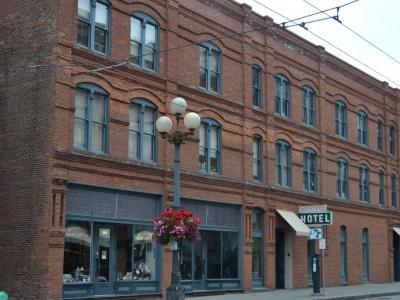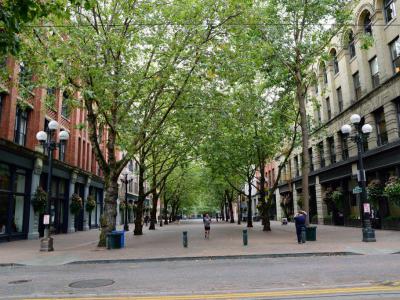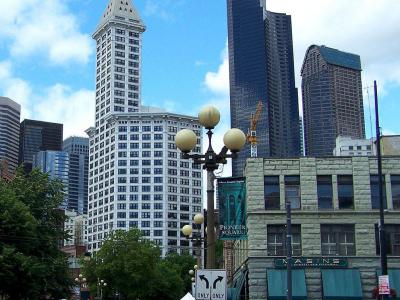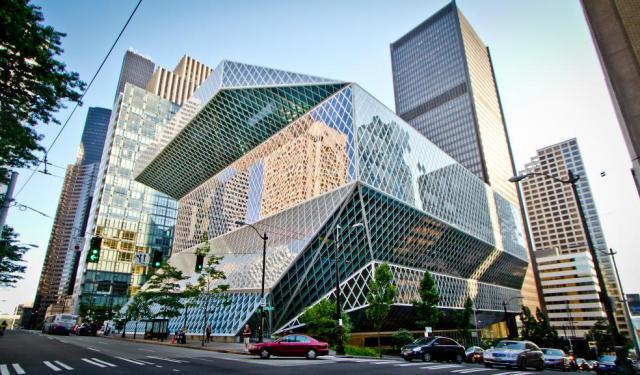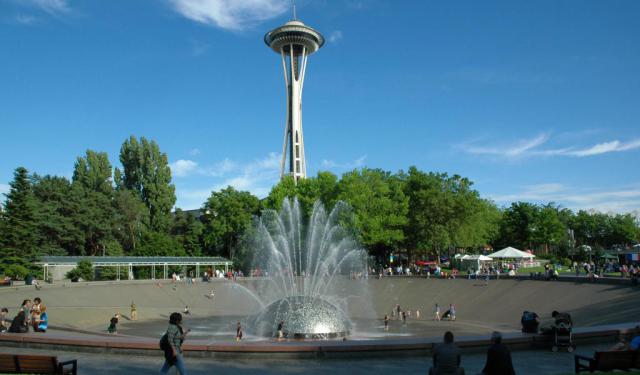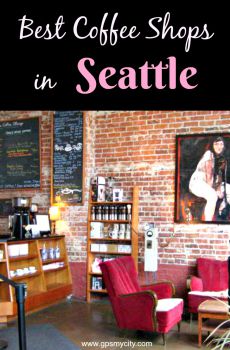
Pioneer Square District Walking Tour (Self Guided), Seattle
Pioneer Square, the district where Seattle was founded in the mid-19th century, had gone through its boom and near-bust until a period of preservation managed to save it for a new life. Today, this is the most historic part of Seattle that holds a special place in the city's yesteryear and is home to several noteworthy landmarks and attractions.
One of the most prominent sites in the area is the King Street Station, a historic train station known for its architecture, serving as a gateway to Seattle for travelers.
For those interested in the Gold Rush era, the Klondike Gold Rush Museum is a must-visit destination. It offers a captivating glimpse into the gold rush history of the late 19th century, with fascinating exhibits and artifacts shedding light on that time.
Nature enthusiasts will appreciate the tranquil oasis of Waterfall Garden Park, a hidden gem in the heart of Pioneer Square. The park's centerpiece is a mesmerizing 22-foot waterfall, providing a peaceful escape from the noise of the city.
Occidental Park is another notable spot in the district, often hosting community events and gatherings. It's a great place to relax, watch people, or enjoy a picnic with friends and family.
The Maynard Building stands tall as a historic architectural gem, while Pioneer Square Park offers a green space for relaxation and reflection. Meanwhile, the iconic Smith Tower, once the tallest skyscraper west of the Mississippi River, is a symbol of Seattle's growth and prosperity.
Pioneer Square is a captivating blend of Seattle's history and contemporary vibrancy. The district is a unique slice of the city that embodies the essence of its growth and dynamism. So, seize the opportunity to explore Pioneer Square on this self-guided walk, as a celebration of Seattle's enduring spirit!
One of the most prominent sites in the area is the King Street Station, a historic train station known for its architecture, serving as a gateway to Seattle for travelers.
For those interested in the Gold Rush era, the Klondike Gold Rush Museum is a must-visit destination. It offers a captivating glimpse into the gold rush history of the late 19th century, with fascinating exhibits and artifacts shedding light on that time.
Nature enthusiasts will appreciate the tranquil oasis of Waterfall Garden Park, a hidden gem in the heart of Pioneer Square. The park's centerpiece is a mesmerizing 22-foot waterfall, providing a peaceful escape from the noise of the city.
Occidental Park is another notable spot in the district, often hosting community events and gatherings. It's a great place to relax, watch people, or enjoy a picnic with friends and family.
The Maynard Building stands tall as a historic architectural gem, while Pioneer Square Park offers a green space for relaxation and reflection. Meanwhile, the iconic Smith Tower, once the tallest skyscraper west of the Mississippi River, is a symbol of Seattle's growth and prosperity.
Pioneer Square is a captivating blend of Seattle's history and contemporary vibrancy. The district is a unique slice of the city that embodies the essence of its growth and dynamism. So, seize the opportunity to explore Pioneer Square on this self-guided walk, as a celebration of Seattle's enduring spirit!
How it works: Download the app "GPSmyCity: Walks in 1K+ Cities" from Apple App Store or Google Play Store to your mobile phone or tablet. The app turns your mobile device into a personal tour guide and its built-in GPS navigation functions guide you from one tour stop to next. The app works offline, so no data plan is needed when traveling abroad.
Pioneer Square District Walking Tour Map
Guide Name: Pioneer Square District Walking Tour
Guide Location: USA » Seattle (See other walking tours in Seattle)
Guide Type: Self-guided Walking Tour (Sightseeing)
# of Attractions: 7
Tour Duration: 1 Hour(s)
Travel Distance: 0.8 Km or 0.5 Miles
Author: doris
Sight(s) Featured in This Guide:
Guide Location: USA » Seattle (See other walking tours in Seattle)
Guide Type: Self-guided Walking Tour (Sightseeing)
# of Attractions: 7
Tour Duration: 1 Hour(s)
Travel Distance: 0.8 Km or 0.5 Miles
Author: doris
Sight(s) Featured in This Guide:
- King Street Station
- Klondike Gold Rush Museum
- Waterfall Garden Park
- Occidental Park
- Maynard Building
- Pioneer Square Park
- Smith Tower
1) King Street Station
One of the last remaining old-style big city depots, King Street Station may not be as grand as New York's Grand Central but is nevertheless good looking for U.S. standards and can even give some train stations in Europe a run for their money. Well over a century old now, it was fully restored to its current glory in 2013. Always clean, bright, and mostly efficiently run, it is the departure point for the fabulous 3½-hour journey to Vancouver, BC, where the train hugs the coastline most of the way.
Architecture enthusiasts and other observant visitors will spot the clock tower's resemblance to Saint Mark's Campanile in Venice, after which it was modeled. This style is sometimes denoted as "Railroad Italianate" due to the definite Italian inspirations, though the structure also shows influences of Beaux-Arts. Inside, at the base of the clock tower, is the entry hall, known as the Compass Room – so it's pretty much like going to a museum rather than a rail station. The interior mosaic is a work of art!
As for the terrain around the station, much of it is, interestingly enough, reclaimed land from what was once the bay. As much as 60 million cubic feet (1.7 million cubic meters) of earth was used for landfill and to raise the level of the city.
Tip:
To get a much better view of this station, take the time to go up to the second level.
Architecture enthusiasts and other observant visitors will spot the clock tower's resemblance to Saint Mark's Campanile in Venice, after which it was modeled. This style is sometimes denoted as "Railroad Italianate" due to the definite Italian inspirations, though the structure also shows influences of Beaux-Arts. Inside, at the base of the clock tower, is the entry hall, known as the Compass Room – so it's pretty much like going to a museum rather than a rail station. The interior mosaic is a work of art!
As for the terrain around the station, much of it is, interestingly enough, reclaimed land from what was once the bay. As much as 60 million cubic feet (1.7 million cubic meters) of earth was used for landfill and to raise the level of the city.
Tip:
To get a much better view of this station, take the time to go up to the second level.
2) Klondike Gold Rush Museum
Located inside a historic redbrick building with wooden floors and soaring ceilings is this tiny yet fascinating museum with exhibits and photographs recounting the saga of the hectic 1890s, when half of Seattle caught Gold Rush fever. Thousands, including the mayor, left jobs and homes to follow the call of gold. The difficult journey 1,500 miles (2,400 kilometers) north to Alaska started with the steamship from Seattle to Skagway, and then continued onward by foot, over forbidding mountains and up treacherous rivers. Few of the spur-of-the-moment adventurers struck it rich, however, since most of the valuable claims had already been staked long before the newcomers' arrival. Many of those who stayed behind in Seattle did better. To ensure that prospectors could withstand the northern wastes, Canadian authorities insisted that they brought with them a year's supply of goods and provisions (400lbs/180kg of flour and 25 cans of butter, for example), and many of the city's early merchants did very brisk trade.
The storytelling here is good and gives a real appreciation of both the mania for gold and the many challenges the prospectors faced. While most walls are lined with photos of gold miners, explorers, and the hopeful families who followed them, others are themed on the development of Seattle and the Pacific North West. Film presentations, live gold-panning demonstrations, and rotating exhibits are scheduled throughout the year.
Refreshingly, also, due to being administered by the National Parks Service, this museum is free – therefore a perfect place for the frugal individual or family.
The storytelling here is good and gives a real appreciation of both the mania for gold and the many challenges the prospectors faced. While most walls are lined with photos of gold miners, explorers, and the hopeful families who followed them, others are themed on the development of Seattle and the Pacific North West. Film presentations, live gold-panning demonstrations, and rotating exhibits are scheduled throughout the year.
Refreshingly, also, due to being administered by the National Parks Service, this museum is free – therefore a perfect place for the frugal individual or family.
3) Waterfall Garden Park
The enclosed Waterfall Garden Park is a charming miniature oasis and a great place for a picnic away from the bustle of the city. It was built in gratitude to the employees of the United Parcel Service (UPS), founded in Seattle in 1907 by 19-year old local resident James Casey. The park's tables are set around flowers and Gingko trees in front of a glorious waterfall designed by Masao Kinoshita, which drops 22 feet (6.7 meters) onto huge boulders and recycles 5,000 gallons (20,000 liters) of water every minute.
Cascading water soothes tension, as evidenced by many "soundscape" recordings and miniature waterfalls in dentists' offices. As soon as you enter this free park, the tensions you may previously had experienced will fade away. Well done, Seattle!
Why You Should Visit:
Neat little spot to eat your lunch, bring your to-go coffee, or just recharge with a waterfall. The sound of water cascading down makes you forget everything else.
Cascading water soothes tension, as evidenced by many "soundscape" recordings and miniature waterfalls in dentists' offices. As soon as you enter this free park, the tensions you may previously had experienced will fade away. Well done, Seattle!
Why You Should Visit:
Neat little spot to eat your lunch, bring your to-go coffee, or just recharge with a waterfall. The sound of water cascading down makes you forget everything else.
4) Occidental Park
Occidental Park is more of a European-type cobblestone square/plaza where tourists, art lovers, shoppers and wanderers visit on a fair weather day. Works of art include totem poles carved over a 10-year period by eminent Chinookan carver Duane Pasco, and are positioned following the tradition of having their faces to the sea and hollowed backs to the forest, though the forest is now the city's skyscrapers. The tallest totem in Occidental Park – "Sun and Raven" – depicts the Raven bringing light to the world. The second totem, "Tsonoqua", is a human figure with outstretched arms; the other two totems are "Bear" and "Man Riding on Tail of Whale".
Also in the park is a memorial to Seattle firefighters who have died in the line of duty since 1889, when the city's Fire Department was formed after the Great Fire. The bronzed sculpture features four life-size firefighters in action.
Otherwise, it's a great place to play outdoor table tennis, foosball, bocce ball, chess, and checkers. There is also a small kids play area and, to top it off, the park is full of small tables and chairs, with some nice artisan shops and cafes nearby.
Also in the park is a memorial to Seattle firefighters who have died in the line of duty since 1889, when the city's Fire Department was formed after the Great Fire. The bronzed sculpture features four life-size firefighters in action.
Otherwise, it's a great place to play outdoor table tennis, foosball, bocce ball, chess, and checkers. There is also a small kids play area and, to top it off, the park is full of small tables and chairs, with some nice artisan shops and cafes nearby.
5) Maynard Building
The Maynard Building, was originally designed by architect Albert Wickersham in 1892 to house Dexter Horton's nascent banking business, which eventually grew into Seafirst Bank. With its beautifully composed elevations, fine detailing and delicate Romanesque Revival carving, it has been praised by many, including Sally Woodbridge, who stated in A Guide to Architecture in Washington State: "The most sophisticated of the Chicago School buildings of the area, it is true to the Sullivanesque principle of weaving spandrel and pier to create a refined and structurally expressive design."
Clad in buff brick and sandstone, the five-story building is rectangular in plan and also has a basement level, partially visible from the street. It now houses mainly office space in a beautifully furbished interior, with a few businesses on the first floor, including Pegasus Coffee. There is no doorman or lobby desk, so you can just go straight up the elevator to whatever floor you want. A beautiful (though small) roof deck faces west, but you need a key code to reach it.
Clad in buff brick and sandstone, the five-story building is rectangular in plan and also has a basement level, partially visible from the street. It now houses mainly office space in a beautifully furbished interior, with a few businesses on the first floor, including Pegasus Coffee. There is no doorman or lobby desk, so you can just go straight up the elevator to whatever floor you want. A beautiful (though small) roof deck faces west, but you need a key code to reach it.
6) Pioneer Square Park
Pioneer Park has long been dominated by a Victorian iron-and-glass pergola built in 1905 and which once sheltered the patrons of a 1.3-mile (2.1 kilometers) cable-car route. Destroyed by a truck in 2001, the pergola was so popular that a new cast- and wrought-iron one – with a safer and stronger steel structure – was unveiled less than two years later. Adjacent is the totem pole made by the Tlingit tribe of Alaska, and a bust of Chief Sealth (or Seattle) perched upon a drinking fountain.
Opposite the pergola is the Merchant's Cafe, the city's oldest restaurant, which in Gold Rush times served 5-cent beers to miners, as they waited for their turn in the brothel upstairs. Seattle's Great Fire of 1889 wiped out almost all of the bar's neighbors in the Pioneer Square area, and architect Elmer Fisher, who was responsible for at least 50 of the new structures, set the new dominant style. A characteristic example of his work is the elegant Pioneer Building (600 1st Avenue) on the plaza, whose tenants included several dozen mining companies above a saloon, which was once operated by Dr 'Doc' Maynard, one of the area's first and pre-eminent settlers.
Tip:
Doc Maynard's former saloon is now the starting point of the popular Bill Speidel's Underground Tour, an inspection of the shops and rooms that were abandoned when this part of town was rebuilt. The tour takes in a warren of the musty, debris-lined passageways and rooms that had been at ground level, and ends at the Rogue's Gallery, where old photos, magazines, artifacts, and scale models depict the area as it was before the fire. Ghost enthusiasts can also take the Paranormal Tour.
Opposite the pergola is the Merchant's Cafe, the city's oldest restaurant, which in Gold Rush times served 5-cent beers to miners, as they waited for their turn in the brothel upstairs. Seattle's Great Fire of 1889 wiped out almost all of the bar's neighbors in the Pioneer Square area, and architect Elmer Fisher, who was responsible for at least 50 of the new structures, set the new dominant style. A characteristic example of his work is the elegant Pioneer Building (600 1st Avenue) on the plaza, whose tenants included several dozen mining companies above a saloon, which was once operated by Dr 'Doc' Maynard, one of the area's first and pre-eminent settlers.
Tip:
Doc Maynard's former saloon is now the starting point of the popular Bill Speidel's Underground Tour, an inspection of the shops and rooms that were abandoned when this part of town was rebuilt. The tour takes in a warren of the musty, debris-lined passageways and rooms that had been at ground level, and ends at the Rogue's Gallery, where old photos, magazines, artifacts, and scale models depict the area as it was before the fire. Ghost enthusiasts can also take the Paranormal Tour.
7) Smith Tower (must see)
At the end of the 19th century, an inventor named Lyman Cornelius Smith arrived in Seattle. Already wealthy from the sale of his gun company (later Smith & Wesson) and then his revolutionary new typewriter (later to be Smith Corona), Smith promptly bought several blocks around Main Street and 1st Avenue.
In 1901, he built the L.C. Smith Building. Goaded by the plans of a business rival, he then plotted the 42-story Smith Tower. When it was completed in 1914, this was the tallest building outside New York. The distinction was gradually diluted until in 1962, its last remaining title – that of the tallest building in Seattle – was taken by the Space Needle. Smith Tower remains a sentimental favorite, however, and the views from the small Observation Deck is sweeping, taking in all four directions: waterfront, Pioneer Square, the mountains surrounding Seattle, etc.
The tower's 35th floor also has the well known Chinese Room with its carved wood, porcelain ceiling, and elaborate Chinese wooden furniture.
Why You Should Visit:
To enjoy great 360-degree views of Seattle without paying the elaborate Space Needle fees.
There is an outside area around the perimeter, and the inside lounge with bar is definitely old-world; even the elevator is fun!
Prior to going up, a small interactive museum helps give you all the history of the time the building was built (1911-1914).
Tip:
Buy advance tickets online or look out for the "happy hour" visiting times – or if you do the nearby Underground Tour, keep the ticket for discounted entry.
In 1901, he built the L.C. Smith Building. Goaded by the plans of a business rival, he then plotted the 42-story Smith Tower. When it was completed in 1914, this was the tallest building outside New York. The distinction was gradually diluted until in 1962, its last remaining title – that of the tallest building in Seattle – was taken by the Space Needle. Smith Tower remains a sentimental favorite, however, and the views from the small Observation Deck is sweeping, taking in all four directions: waterfront, Pioneer Square, the mountains surrounding Seattle, etc.
The tower's 35th floor also has the well known Chinese Room with its carved wood, porcelain ceiling, and elaborate Chinese wooden furniture.
Why You Should Visit:
To enjoy great 360-degree views of Seattle without paying the elaborate Space Needle fees.
There is an outside area around the perimeter, and the inside lounge with bar is definitely old-world; even the elevator is fun!
Prior to going up, a small interactive museum helps give you all the history of the time the building was built (1911-1914).
Tip:
Buy advance tickets online or look out for the "happy hour" visiting times – or if you do the nearby Underground Tour, keep the ticket for discounted entry.
Walking Tours in Seattle, Washington
Create Your Own Walk in Seattle
Creating your own self-guided walk in Seattle is easy and fun. Choose the city attractions that you want to see and a walk route map will be created just for you. You can even set your hotel as the start point of the walk.
Historical Religious Buildings Tour
Seattle, Washington, boasts a wealth of religious sites of various denominations – together reflecting the city's diverse spiritual heritage. Besides being purely centers of faith, these buildings are an important part of the city's historical heritage, some of them standing as architectural marvels, each with its unique story.
Trinity Parish Church, founded in 1865, is... view more
Tour Duration: 2 Hour(s)
Travel Distance: 3.1 Km or 1.9 Miles
Trinity Parish Church, founded in 1865, is... view more
Tour Duration: 2 Hour(s)
Travel Distance: 3.1 Km or 1.9 Miles
Seattle Introduction Walking Tour
Overlooking Puget Sound's Elliott Bay on the West Coast of the United States, the port city of Seattle is renowned for its surrounding waters, mountains, evergreen forests, and thousands of acres of parkland. The largest metropolitan area in today's Washington State had been inhabited by Native Americans for at least 4,000 years prior to the European pioneers. The first European to set... view more
Tour Duration: 2 Hour(s)
Travel Distance: 4.3 Km or 2.7 Miles
Tour Duration: 2 Hour(s)
Travel Distance: 4.3 Km or 2.7 Miles
Seattle Architecture Walking Tour
In terms of towering skyscrapers abuzz with commerce, upscale shopping & dining, and splendid theaters, Downtown Seattle resembles many American cities. At the same time, it is also unexpectedly pleasant with hills, outdoor sculptures, and peek-a-boo views of Elliot Bay's sparkling water. Still, the diverse architectural landscape of the city is distinctive primarily for its landmark... view more
Tour Duration: 2 Hour(s)
Travel Distance: 2.1 Km or 1.3 Miles
Tour Duration: 2 Hour(s)
Travel Distance: 2.1 Km or 1.3 Miles
Seattle Center Walking Tour
Immediately north of Downtown Seattle, you will find the ever-popular Seattle Center. Developed for the 1962 World's Fair, this 30-hectare (74-acre) park and arts & entertainment center contains numerous landmarks. It is also where Seattle's biggest festivals, concerts, film screenings, and theatrical performances are held.
At the heart of this bustling area stands the iconic... view more
Tour Duration: 1 Hour(s)
Travel Distance: 1.1 Km or 0.7 Miles
At the heart of this bustling area stands the iconic... view more
Tour Duration: 1 Hour(s)
Travel Distance: 1.1 Km or 0.7 Miles
Fremont Neighborhood Walking Tour
Fremont is a vibrant neighborhood in Seattle, renowned for its quirky and artistic character. Among other things, this famous district is home to some of Seattle's most beloved and controversial sculptures.
One of its most iconic landmarks is the Fremont Troll, a massive sculpture of a troll lurking underneath the Aurora Bridge.
At the height of its counterculture days, Fremont renamed... view more
Tour Duration: 2 Hour(s)
Travel Distance: 3.1 Km or 1.9 Miles
One of its most iconic landmarks is the Fremont Troll, a massive sculpture of a troll lurking underneath the Aurora Bridge.
At the height of its counterculture days, Fremont renamed... view more
Tour Duration: 2 Hour(s)
Travel Distance: 3.1 Km or 1.9 Miles
Useful Travel Guides for Planning Your Trip
Best Coffee Shops in Seattle
Explore Seattle’s top coffee shops to get a real sense of the eclectic and culturally diverse caffeine buzzed city. Whether you desire a chic downtown coffee café with lots of windows and swanky décor or a dark coffee shop with mix-matched furniture, strong espresso, free wireless and lots of...
14 Distinctively Seattle Things to Buy as Souvenirs
With the penchant for coffee they have in Seattle, no wonder they go sleepless. Other than that, the Emerald City is renowned for quite a few "distinctively Seattle" things that make it stand out from the crowd of other major urban U.S. destinations. Here are some tips as to which they are...
The Most Popular Cities
/ view all

